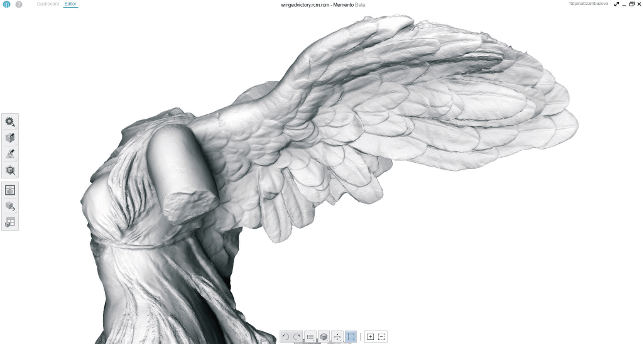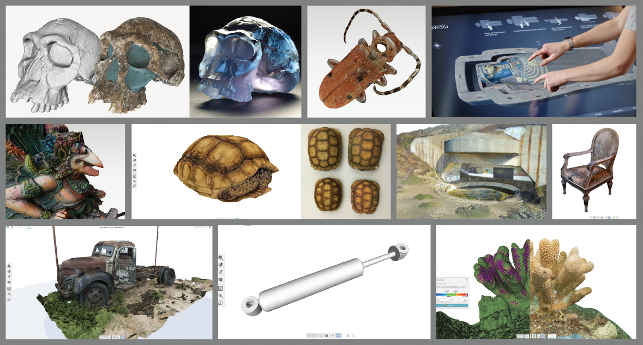
Memento is a cross platform software product (for both Mac and Windows) that allows users to work with data from photogrammetry and 3D scanners
Powerful sensors are becoming ubiquitous and they make it easier than ever to capture and digitise the world around us. The camera sensors on our mobile phones or pocket cameras today are of similar power to professional cameras that used to cost thousands of dollars only few years ago.
Laser scanners are becoming better and more affordable; new types of sensors of various strengths and qualities are flooding into the market (for example, Kinect, Tango and handheld structured light scanners.)
All of these sensor-powered devices are able to capture the analogue world and convert it into digital data. But while making 3D models from reality is becoming more mainstream every day, making those 3D models really usable for various specific workflows is a challenging and tedious process – usually slow, requiring high-end expertise and the use of multiple expensive software solutions.
Autodesk Memento aims to simplify that process into one single application, designed to cover the entire process from capture through final asset to further digital or fabrication workflows.
Memento has been designed for users who require top-quality digital models of real-life objects but have little or no 3D modelling expertise. And for those with greater expertise, Memento offers tools to dig deeper. For the first time, reality computing is scalable and accessible to a wide variety of users.
Combining power with ease of use
Unlike 3D models created with CAD or modelling programmes, 3D meshes generated from reality can be huge in size and polygon count.
Most of the existing software has not been designed to handle billions of polygons, which makes the process of creating or preparing such meshes frustratingly slow or even impossible.
Created specifically for reality workflows, and with a powerful mesh-streaming engine that can handle billions of polygons, Memento is ready for the avalanche of sensor data that is coming our way and will work with it easily and fluidly.
Optimisation
So what happens to the mesh after an asset is complete?
Downstream software and new types of hardware devices, such as 3D printers and AR/VR sets, are limited by the number of polygons they can handle. Even the most expensive 3D printers can max out at meshes with 150,000 polygons, while AR/VR devices saturate at just a fraction of that.
With smart decimation, you can reduce the number of polygons (for 3D printing, tools like 123D Make or bringing into design workflows) and with Memento’s ability to rebake the texture on decimated models (normal, occlusion, displacement and diffuse map).
Additionally, Memento can make even the most decimated, smallin-polygon-size model still look gorgeous when published digitally, for web and mobile.
Memento can also read any mesh generated inother capture or modelling software and do the optimisation for them.
Publishing and sharing
Memento users can publish their models for interactive exploration in-browser via hyperlinks or embedded in web sites.
Users and use cases
Professionals from different industries are starting to recognise the new opportunities opened up by this democratised digitisation of reality.

A range of potential use cases and current project work, from capturing of fossils, to heritage, art, asset creation for film, games, AR/VR and conservation (for image credits and links to pioneering work see foot of article)
Media artists, filmmakers, photographers, VFX experts, AR/VR solution makers, scientists, researchers, heritage experts, museum curators, traditional sculptors, designers, engineers, architects, medical experts, 3D printing services and many others already use Memento in order to create high definition 3D digital replicas of real objects for one of the following purposes (to name just a few):
Archive: Objects or scenes (heritage, museums, science, archeology, art, forensics.)
Create reality-resembling assets: Use in AR/VR reality solutions, games, films or for creating physical props and sets for them (media and entertainment industries, tourism, new wave of AR/VR storytellers.)
Make physical copies: Reproduction of the digitised object in size or materials other than the original or for making physical negatives for moulds, casts, even crates and so on, using 3D printing, bronze casting, CNC machining.
Monitor and document change: Can be used to capture how an object changes, alters, deforms or erodes over time, whether that’s natural resources, built structures, products, art work and so on. Future opportunities involve quality control.
Bridge analog/digital/analog in the arts: Many artists still like to work with traditional media, using their hands (to shape clay or stone, for example) but still see the potential of digitised art.
With Memento, they can continue working in with methods and mediums that are comfortable and familiar to them and only then digitise the sculpture or design, continue exploring it digitally, to finally use the asset digitally, for story telling or to make a new physical replica in different size or material, using traditional or digital fabrication methods.
Restore/repair: Restore, repair or conserve old or damaged assets that have been manually made or are artifacts of the past and no longer in production.
Design: Use for design of bespoke, personalised accessories or medical equipment, as context for design, for reference or inspiration, for test-fitting a new design in existing reality or an existing object in designed reality.
Education: Introducing new kinds of tactile experiences using physical replicas or interactive online learning, as well as assistative objects for those with additional needs.
The official product launch of Autodesk Memento is expected to take place in mid-March 2016. It will be exciting to see where all these different industries will take the product!
Autodesk Memento is currently available as free Beta download
memento.autodesk.com
Image credits and links to pioneering work:
■ africanfossils.org
■ hardshelllabs.com
■ 3dtam.eu
■ thehydro.us
■ 3d.si.edu
■ cosmowenman.wordpress.com
■ gigamacro.com
■ knowledge.nuvolaverde.org
■ interspectral.com
■ artec3d.com
■ mantis-vision.com

Tatjana captured by Factum-arte’s Veronica Chorographic scanner
Tatjana Dzambazova is a technology whisperer and senior product manager at Autodesk.
Image credit: Tatjana captured by Factum-arte’s Veronica Chorographic scanner (factum-arte.com)
A look at what makes the reality computing software unique
[sponsored content]
Default






